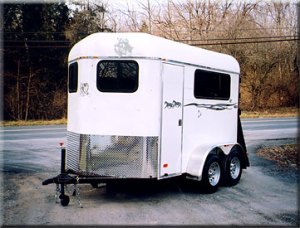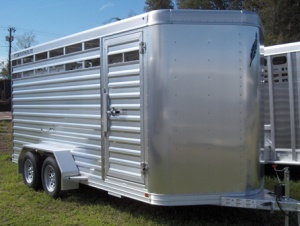Having worked with horses and livestock for many years, I have dealt with a variety of trailers to transport them. I have personally owned all bumper pulls, starting with my parents 2 trailers: a standard, steel, 2-horse, straight-load trailer, and a Logan Coach Competitor, all steel, 4-horse slant model with nice tack/dressing room. For our wedding, S arrived with a (new to us) truck pulling a Cotner, steel frame, aluminum skin, fiberglass roof, ramp load 2-horse trailer, which quickly became a favorite. Later, our circumstances required a change, so we switched to an all-aluminum, Featherlite, 16 foot BP stock trailer, which became another favorite thanks to its versatility. I have had the opportunity to pull a goosneck trailer, and loaded horses into MANY other trailers (usually when their owners were unable to do so!). Frankly, there are almost unlimited designs to choose from: all aluminum, all steel, aluminum skin on steel frame, fiberglass roofing, and composite mixtures of all sorts; goosenecks and bumper pulls; drop down windows, open slats, or pipe sides; straight load, slant load, rear-facing, or box stalls; rubber floors, rumber flooring, aluminum flooring, wood floors, and other types of flooring; rubber mats on floor and/or sides, or no mats; tack rooms and/or dressing rooms in front and back, or not; full rear doors, half rear doors, and doors with sliders; and so many others! It can be overwhelming. I have learned that every trailer has their advantages and disadvantages.
Now that we are on the look-out for a trailer to move our farm in the upcoming months, and our needs are very different that what they used to be, I began my search with some serious research. I’ve read many articles about trailers online, but the problem with almost all these articles is that they are usually somewhat influenced, if not entirely written by, a particular trailer manufacturer, resulting in very biased opinions. The few articles I found that were unbiased were usually written by someone using a brand-new trailer for the evaluation and comparison. There is a website by “Mr. Truck,” aka “Mr. Trailer” that has some great reviews of all sorts of trailers. The problem I found there, however, was that it didn’t discuss how trailers held up in the long run. It focused more on comfort features and such. So, I turned to making phone calls. I talked to manufacturers and dealers, and asked for quotes, in order to compare features, designs, and prices. Eventually, I stumbled upon a wonderful local lady who owns a trailer repair company, and quickly discovered that she was exactly who I needed to talk to.
This lady had her own horses and livestock, and had for many years, plus she sold custom trailers on the side, so she was familiar with the different dealers and manufacturers. She dealt with lots of used trailers on consignment, so she was familiar with who got rid of what and why, and who was buying what and why. Most importantly, though, was her repair shop. She knew which trailers came in with what problems and whether those problems were flukes or consistent issues with that brand or model of trailer. She was happy to discuss these issues with me to aid in our search for our “perfect” trailer, with no promise that I would purchase anything from her (in fact, she knew I was talking to other dealers and searching Craigslist). She just seemed sincerely interested in helping people find a trailer they could be happy with, that would keep their animals safe, and that would be the most economical investment for their hard-earned cash.
Finally, my husband is a mechanical engineer by trade, and he works with all sorts of engineers with differing specialties. He discussed trailer materials and building components with his buddies for a more technical understanding of how the ideal trailer would be put together.
To prevent this post from being too long, I will break it up into several posts. Tomorrow, I will discuss some of my findings based on my personal experience and recent research of horse and livestock trailers.




